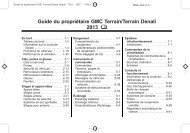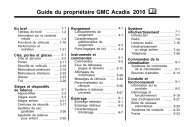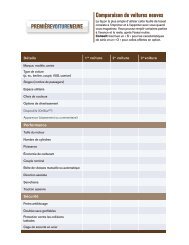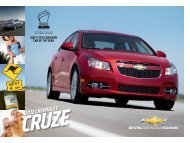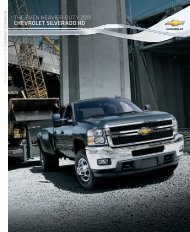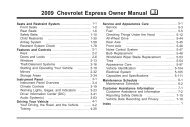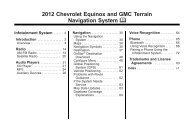- Page 1 and 2: 2003 Pontiac Aztek Owner Manual M S
- Page 3 and 4: Index A good place to look for what
- Page 5 and 6: These are some examples of vehicle
- Page 7 and 8: Section 1 Seats and Restraint Syste
- Page 9 and 10: Manual Lumbar Heated Seats The knob
- Page 11 and 12: {CAUTION: Sitting in a reclined pos
- Page 13 and 14: To fold the seatback forward lift u
- Page 15 and 16: {CAUTION: A safety belt that is imp
- Page 17 and 18: {CAUTION: It is extremely dangerous
- Page 19 and 20: Get it up to speed. Then stop the v
- Page 21 and 22: Questions and Answers About Safety
- Page 23 and 24: 5. To make the lap part tight, pull
- Page 25 and 26: Q: What’s wrong with this? {CAUTI
- Page 27 and 28: Q: What’s wrong with this? {CAUTI
- Page 29 and 30: Q: What’s wrong with this? {CAUTI
- Page 31 and 32: The best way to protect the fetus i
- Page 33 and 34: If the belt stops before it reaches
- Page 35 and 36: Center Rear Passenger Position Lap-
- Page 37 and 38: 3. To make the lap belt longer, til
- Page 39 and 40: 2. Place the guide over the belt an
- Page 41 and 42: 2. Attach the elastic cord to the c
- Page 43 and 44: Q: What is the proper way to wear s
- Page 45 and 46: {CAUTION: Never do this. Here a chi
- Page 47: {CAUTION: Children who are up again
- Page 51 and 52: A booster seat (F-G) is a child res
- Page 53 and 54: Top Strap Some child restraints hav
- Page 55 and 56: Lower Anchorages and Top Tethers fo
- Page 57 and 58: {CAUTION: If a LATCH-type child res
- Page 59 and 60: 4. To tighten the belt, pull up on
- Page 61 and 62: 5. To tighten the belt, pull its fr
- Page 63 and 64: If the shoulder belt goes in front
- Page 65 and 66: Air Bag Systems This part explains
- Page 67 and 68: {CAUTION: Both frontal and side imp
- Page 69 and 70: The right front passenger’s front
- Page 71 and 72: If your vehicle strikes something t
- Page 73 and 74: {CAUTION: When an air bag inflates,
- Page 75 and 76: Replacing Restraint System Parts Af
- Page 77 and 78: Section 2 Features and Controls Key
- Page 79 and 80: Keys {CAUTION: Leaving children in
- Page 81 and 82: This device complies with RSS-210 o
- Page 83 and 84: Battery Replacement Under normal us
- Page 85 and 86: Power Door Locks The power door loc
- Page 87 and 88: Canceling the Rear Door Security Lo
- Page 89 and 90: Windows {CAUTION: Leaving children
- Page 91 and 92: Theft-Deterrent Systems Vehicle the
- Page 93 and 94: PASS-Key ® III Operation Your vehi
- Page 95 and 96: Ignition Positions With the key in
- Page 97 and 98: Engine Coolant Heater Your vehicle
- Page 99 and 100:
Notice: Shifting to REVERSE (R) whi
- Page 101 and 102:
Shift Lock Release This vehicle is
- Page 103 and 104:
2. Move the shift lever into PARK (
- Page 105 and 106:
Engine Exhaust {CAUTION: Engine exh
- Page 107 and 108:
If you are not adjusting either mir
- Page 109 and 110:
Cupholder(s) There are cupholders l
- Page 111 and 112:
Console/Cooler {CAUTION: If the coo
- Page 113 and 114:
To prevent damage or loss of cargo
- Page 115 and 116:
To replace the sunroof stop, do the
- Page 117 and 118:
The two side nets can go on either
- Page 119 and 120:
Removing the Floor Track Assembly A
- Page 121 and 122:
Sunroof If your vehicle has a sunro
- Page 123 and 124:
Your vehicle was originally program
- Page 125 and 126:
Your vehicle was originally program
- Page 127 and 128:
Your vehicle was originally program
- Page 129 and 130:
Section 3 Instrument Panel Instrume
- Page 131 and 132:
✍ NOTES 3-3
- Page 133 and 134:
The main components of the instrume
- Page 135 and 136:
Tilt Wheel Turn Signal/Multifunctio
- Page 137 and 138:
Flash-to-Pass When the headlamps ar
- Page 139 and 140:
Resuming a Set Speed Suppose you se
- Page 141 and 142:
A light sensor on top of the instru
- Page 143 and 144:
Entry Lighting With entry lighting,
- Page 145 and 146:
Front Reading Lamps There are two r
- Page 147 and 148:
The HUD controls are located to the
- Page 149 and 150:
Ashtrays and Cigarette Lighter If y
- Page 151 and 152:
For quick cool down on hot days, do
- Page 153 and 154:
) (Bi-Level): This mode directs hal
- Page 155 and 156:
Rear Window Defogger The rear windo
- Page 157 and 158:
Instrument Panel Cluster Your instr
- Page 159 and 160:
Retro-Active Reset The trip odomete
- Page 161 and 162:
The air bag readiness light should
- Page 163 and 164:
Engine Coolant Temperature Gage Mal
- Page 165 and 166:
If the light continues to flash, wh
- Page 167 and 168:
Here are four things that some owne
- Page 169 and 170:
Charging System Indicator Message L
- Page 171 and 172:
Change Engine Oil Message Low Tire
- Page 173 and 174:
All-Wheel Drive Disable Warning Mes
- Page 175 and 176:
Service Vehicle Soon Message Progra
- Page 177 and 178:
Driver Information Center (DIC) If
- Page 179 and 180:
The DIC controls are located to the
- Page 181 and 182:
3. Press the SET button and TO SELE
- Page 183 and 184:
Interior lighting on will not occur
- Page 185 and 186:
Your vehicle was originally program
- Page 187 and 188:
Your vehicle was originally program
- Page 189 and 190:
This system relies upon receiving s
- Page 191 and 192:
To adjust all of the tone controls
- Page 193 and 194:
INFO (Information): If the current
- Page 195 and 196:
Radio Display Message No Info No In
- Page 197 and 198:
w SCAN x: Press and hold one of the
- Page 199 and 200:
SCV (Speed-Compensated Volume): Wit
- Page 201 and 202:
Adjusting the Speakers (Balance/Fad
- Page 203 and 204:
If the current tuned station does n
- Page 205 and 206:
Radio Display Message No Info No In
- Page 207 and 208:
w SCAN x: Press and hold one of the
- Page 209 and 210:
w SEEK x: Press the down arrow whil
- Page 211 and 212:
Playing the Radio PWR (Power): Push
- Page 213 and 214:
To return to the manual mode (CUSTO
- Page 215 and 216:
INFO (Information): If the current
- Page 217 and 218:
Radio Display Message No Info No In
- Page 219 and 220:
When a disc is inserted, the CD sym
- Page 221 and 222:
Using Song List Mode The integrated
- Page 223 and 224:
Headphones The entertainment system
- Page 225 and 226:
Video Screen The video screen is lo
- Page 227 and 228:
If the disc has been ejected, or if
- Page 229 and 230:
t (Prior Chapter/Track): Press this
- Page 231 and 232:
Tips and Trouble Problem No power.
- Page 233 and 234:
Problem The fast forward, reverse,
- Page 235 and 236:
Audio Steering Wheel Controls If yo
- Page 237 and 238:
For best results, use a scrubbing a
- Page 239 and 240:
Section 4 Driving Your Vehicle Your
- Page 241 and 242:
But driver behavior factors are far
- Page 243 and 244:
means that a woman generally will r
- Page 245 and 246:
Braking Braking action involves per
- Page 247 and 248:
The anti-lock system can change the
- Page 249 and 250:
You should turn the system off if y
- Page 251 and 252:
Steering in Emergencies There are t
- Page 253 and 254:
• Do not get too close to the veh
- Page 255 and 256:
Driving at Night Night driving is m
- Page 257 and 258:
The heavier the rain, the harder it
- Page 259 and 260:
City Driving Here are ways to incre
- Page 261 and 262:
The exit ramp can be curved, someti
- Page 263 and 264:
• Know how to go down hills. The
- Page 265 and 266:
What’s the worst time for this?
- Page 267 and 268:
• Put on extra clothing or wrap a
- Page 269 and 270:
Rocking Your Vehicle To Get It Out
- Page 271 and 272:
The label shows the size of your or
- Page 273 and 274:
Your vehicle can tow a trailer. To
- Page 275 and 276:
If you’re using a weight-carrying
- Page 277 and 278:
Towing a trailer requires a certain
- Page 279 and 280:
2. Have someone place chocks under
- Page 281 and 282:
Section 5 Service and Appearance Ca
- Page 283 and 284:
Service Your dealer knows your vehi
- Page 285 and 286:
Gasoline Specifications It is recom
- Page 287 and 288:
While refueling, let the fuel cap h
- Page 289 and 290:
Hood Release To open the hood, do t
- Page 291 and 292:
A. Underhood Fuse Block. See Fuses
- Page 293 and 294:
When to Add Engine Oil If the oil i
- Page 295 and 296:
As in the chart shown previously, S
- Page 297 and 298:
How to Inspect the Engine Air Clean
- Page 299 and 300:
Checking the Fluid Level Prepare yo
- Page 301 and 302:
Notice: When adding coolant, it is
- Page 303 and 304:
{CAUTION: You can be burned if you
- Page 305 and 306:
If No Steam Is Coming From Your Eng
- Page 307 and 308:
CAUTION: (Continued) Don’t run th
- Page 309 and 310:
If the overheat warning continues,
- Page 311 and 312:
Bypass Tube Housing 3. After the en
- Page 313 and 314:
Power Steering Fluid 9. Then fill t
- Page 315 and 316:
Notice: • When using concentrated
- Page 317 and 318:
Always clean the brake fluid reserv
- Page 319 and 320:
Vehicle Storage If you’re not goi
- Page 321 and 322:
{CAUTION: Using a match near a batt
- Page 323 and 324:
Notice: Damage to your vehicle may
- Page 325 and 326:
If the level is below the bottom of
- Page 327 and 328:
12. Align the retaining clips on th
- Page 329 and 330:
Replacement Bulbs Lamp Bulb Number
- Page 331 and 332:
Notice: Don’t let anyone tell you
- Page 333 and 334:
To reset the system: 1. Turn the ig
- Page 335 and 336:
When It Is Time for New Tires One w
- Page 337 and 338:
While the tires available on Genera
- Page 339 and 340:
Used Replacement Wheels {CAUTION: P
- Page 341 and 342:
To use your accessory inflator syst
- Page 343 and 344:
Removing the Spare Tire and Tools T
- Page 345 and 346:
4. To remove the spare tire from th
- Page 347 and 348:
1. Push the release lever located i
- Page 349 and 350:
Secondary Latch System Your vehicle
- Page 351 and 352:
6. Lower the jack by turning the fo
- Page 353 and 354:
4. Turn the folding wrench clockwis
- Page 355 and 356:
Notice: To help avoid damage to loc
- Page 357 and 358:
{CAUTION: Incorrect wheel nuts or i
- Page 359 and 360:
4. Attach the folding wrench to the
- Page 361 and 362:
3. Remove the J-hook and the wing n
- Page 363 and 364:
All-Wheel Drive After installing a
- Page 365 and 366:
Stains caused by candy, ice cream,
- Page 367 and 368:
Cleaning Exterior Lamps/Lenses Use
- Page 369 and 370:
Underbody Maintenance Chemicals use
- Page 371 and 372:
Service Parts Identification Label
- Page 373 and 374:
Fuse Usage 1 Fuse Puller 2 Steering
- Page 375 and 376:
Fuse Usage 1 Fuel Pump 2 Air Condit
- Page 377 and 378:
Circuit Breaker 49 Spare Usage Rela
- Page 379 and 380:
Engine Specifications Engine VIN Co
- Page 381 and 382:
Section 6 Maintenance Schedule Main
- Page 383 and 384:
How This Section is Organized This
- Page 385 and 386:
Scheduled Maintenance The services
- Page 387 and 388:
50,000 Miles (83 000 km) ❑ Change
- Page 389 and 390:
Part B: Owner Checks and Services L
- Page 391 and 392:
Starter Switch Check {CAUTION: When
- Page 393 and 394:
Part C: Periodic Maintenance Inspec
- Page 395 and 396:
Part D: Recommended Fluids and Lubr
- Page 397 and 398:
Date Odometer Reading Maintenance R
- Page 399 and 400:
Section 7 Customer Assistance Infor
- Page 401 and 402:
The BBB Auto Line Program is an out
- Page 403 and 404:
Canada - Customer Assistance Genera
- Page 405 and 406:
Pontiac reserves the right to limit
- Page 407 and 408:
Courtesy Transportation is availabl
- Page 409 and 410:
Service Bulletins Service Bulletins
- Page 411 and 412:
A About Driving Your Vehicle ......
- Page 413 and 414:
Cargo Net System ..................
- Page 415 and 416:
Driver Information Center (DIC) ...
- Page 417 and 418:
G Gage ............................
- Page 419 and 420:
Light .............................
- Page 421 and 422:
OnStar ® System ..................
- Page 423 and 424:
Removing the Floor Track Assembly .
- Page 425 and 426:
Spare Tire Check ..................
- Page 427 and 428:
U Underbody Flushing Service ......




